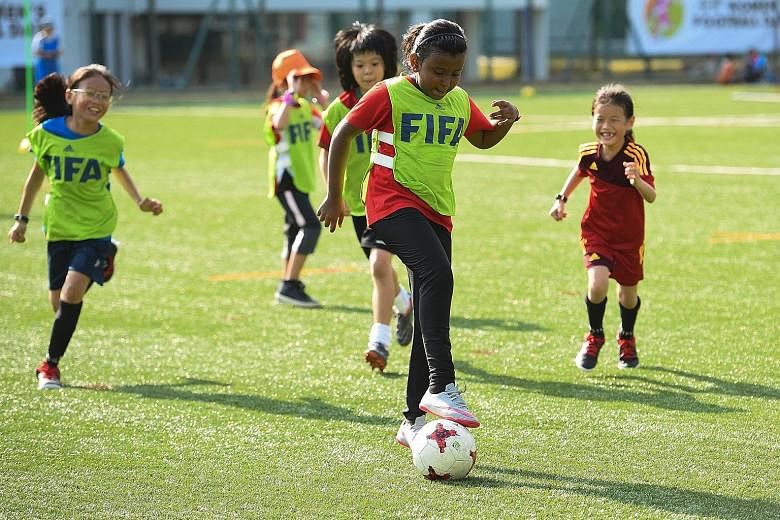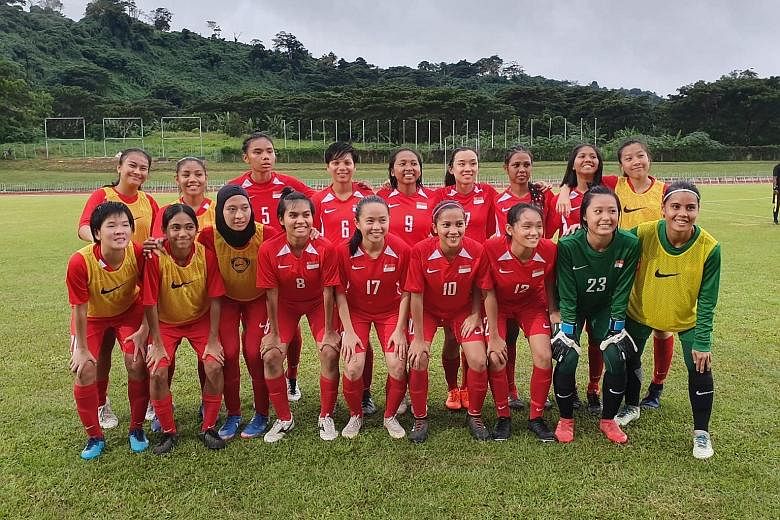Every footballer dreams of playing in, and even winning, the World Cup.
With the ongoing Women's World Cup boosting the popularity of the women's game, a generation of girls are being inspired to emulate players like Marta of Brazil and Alex Morgan of the United States and shine on the world stage.
One woman paying close attention to the matches in France is Chen Wan Xin, whose football dream started 15 years ago, when she was 12.
Her football then was played during recess, but her teammates were all boys. No other girl in Chung Cheng High School (Main) was interested.
"I didn't know that girls played football because there was no women's football shown on TV and YouTube was not as popular as now," she recalled.
"I was living in a bubble, not knowing that there was girls' football. All along, I thought I was playing a 'boy's sport'."
Fast forward to the present.
Football has become Chen's great passion. She is the captain of Home United's women's team and also an executive in grassroots and women's football at the Football Association of Singapore (FAS).
Her journey mirrors the local women's football scene at various levels.
She was the rare girl who played the sport: An FAS survey of primary school pupils in 2014 noted nearly one in two children want to play football. But only 5.9 per cent of boys and 1.6 per cent of girls actually do.
That prompted the FAS to start its first all-girl training centres for those aged five to 12 at Bowen and Queensway Secondary Schools a year later, with a combined intake of about 30.
A third centre will be launched at Meridian Secondary School next month.
FAS general manager for grassroots and women's football, Julie Teo, 56, said: "We hope to increase the number of players who may be nurtured and selected for the national teams, while also increasing the level of professionalism and marketability of women's football to attract sponsors for the domestic leagues and competitions."
Promising players at these FAS centres are placed in an Under-12 development squad that was formed last year.
There are also U-14 and U-16 teams that complement the U-19 and national senior sides.
The domestic league has been expanded in the last few years. There are now about 400 amateur players from 15 clubs playing in the Women's National League and top-tier Women's Premier League, up from eight teams in 2016.
National midfielder Putri Nur Syaliza, 16, who started playing football when she was four, emphasised the importance of the programmes.
"It's good that women's football is having a lot of mini tournaments and games for the younger ones to enjoy and gain more playing experience," she said.
"It's also good that they start developing players from a young age, so... they can have a good foundation."
STILL A WORK IN PROGRESS
Despite the introduction of more national age-group teams, opportunities for youth players - particularly those from the secondary schools - are limited.
Thirteen teams participated in this year's Schools National girls' B Division competition compared to more than 80 in the boys' category.
For those girls aged from 13 to 17 who want to play regularly, they are in limbo - too old for the FAS centres and too young for the amateur clubs that usually do not have a youth programme.
Home United women's team head coach Azrulnizam Shah Sohaimi, 35, said: "More attention has to be paid to the bottom of the pyramid. If we can have 20-30 teams playing, it will create a bigger base of players and drive up standards."
BAKING COOKIES
Financial support is another obstacle.
According to the FAS' annual report for 2017-2018, the total amount spent on women's football was $266,877, compared to the $472,335 budget for running the 23-team men's National Football League.
There was almost no budget when Azrulnizam wanted to start a women's team at Home United in 2016, and it was a struggle just to get basic training items.
"Thankfully I have friends who are coaches too and they had spare equipment like balls and bibs (which we borrowed)," he said.
To fund a training trip to Thailand, the team baked cookies and raised $5,000 to subsidise the costs.
Another oft-cited complaint is the lack of media coverage.
There were 133 print articles about Singapore men's football in The Straits Times last year and just five on women's football.
Former national left-back Nur Aniqah Imana Azman, 28, noted this was the first time she has been interviewed.
The Simei United FC player said: "The media plays a big part in promoting women's football and it should be highlighted just as much as men's football.
"Marketing and support from FAS should be equal for both teams as well. They shouldn't just focus on the men's team but also promote the women's team equally."
BACK FROM THE WILDERNESS
Things are at least looking up for the national women's team.
In January 2015, they played their first international friendly in two years. Since then, they have been involved in 26 games.
Last year, the FAS, with European governing body Uefa's support, hosted an international quadrangular involving the national teams of Indonesia, Luxembourg and Maldives.
After an all-time low of No. 141 in 2015, the Singapore women's team were ranked as high as 89th in 2017. They are now 120th in the field of 155.
The squad, crucially, are also much younger with an average age of 21. These fresh faces help to raise standards, said national centre-back Charmaine Lim, 29.
"The younger players bring a different set of challenges to competitions, even in local leagues, and with more of them, it means that fighting for a position in the national squad will be more competitive."
National captain Angelyn Pang, 28, said the team's next goal is to qualify for the SEA Games for the first time since 2003.
"It may seem like an uphill task but we'll be working hard to improve from our past matches with match analyses and corrective training," she added.
For FAS' Teo, the work never ends. The organisation, she said, has been "conducting outreach programmes in schools to introduce women's football and encourage participation in the sport".
She added: "We will continue to work with the schools to provide support in coaching, training sessions and clinics."
• Additional reporting by Laura Chia


